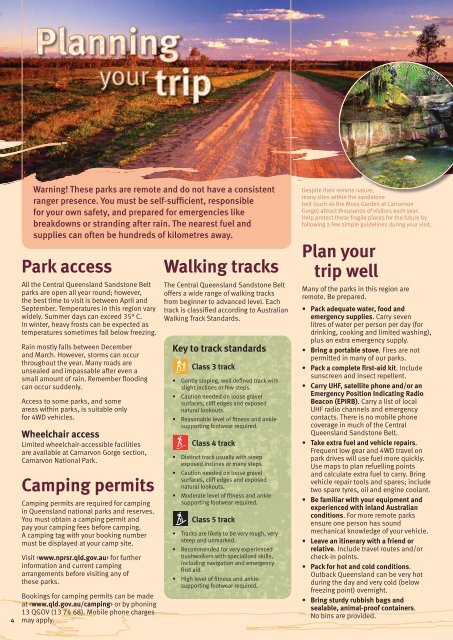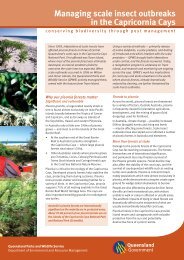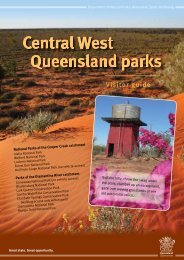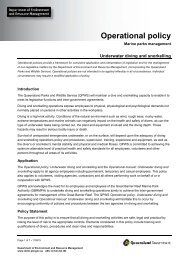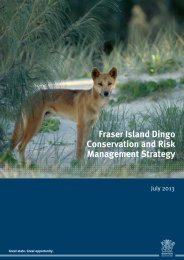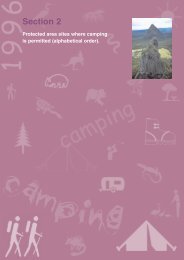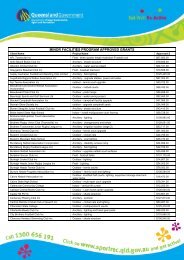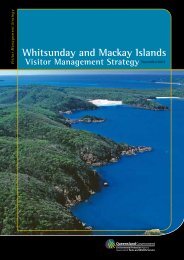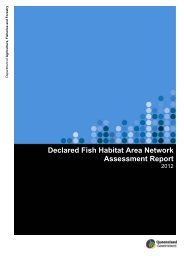Central Queensland Sandstone Belt parks visitor guide (PDF, 4.0M)
Central Queensland Sandstone Belt parks visitor guide (PDF, 4.0M)
Central Queensland Sandstone Belt parks visitor guide (PDF, 4.0M)
You also want an ePaper? Increase the reach of your titles
YUMPU automatically turns print PDFs into web optimized ePapers that Google loves.
Photo: Michael O’Connor, NPRSR.<br />
4<br />
Warning! These <strong>parks</strong> are remote and do not have a consistent<br />
ranger presence. You must be self-sufficient, responsible<br />
for your own safety, and prepared for emergencies like<br />
breakdowns or stranding after rain. The nearest fuel and<br />
supplies can often be hundreds of kilometres away.<br />
Park access<br />
All the <strong>Central</strong> <strong>Queensland</strong> <strong>Sandstone</strong> <strong>Belt</strong><br />
<strong>parks</strong> are open all year round; however,<br />
the best time to visit is between April and<br />
September. Temperatures in this region vary<br />
widely. Summer days can exceed 35° C.<br />
In winter, heavy frosts can be expected as<br />
temperatures sometimes fall below freezing.<br />
Rain mostly falls between December<br />
and March. However, storms can occur<br />
throughout the year. Many roads are<br />
unsealed and impassable after even a<br />
small amount of rain. Remember flooding<br />
can occur suddenly.<br />
Access to some <strong>parks</strong>, and some<br />
areas within <strong>parks</strong>, is suitable only<br />
for 4WD vehicles.<br />
Wheelchair access<br />
Limited wheelchair-accessible facilities<br />
are available at Carnarvon Gorge section,<br />
Carnarvon National Park.<br />
Camping permits<br />
Camping permits are required for camping<br />
in <strong>Queensland</strong> national <strong>parks</strong> and reserves.<br />
You must obtain a camping permit and<br />
pay your camping fees before camping.<br />
A camping tag with your booking number<br />
must be displayed at your camp site.<br />
Visit for further<br />
information and current camping<br />
arrangements before visiting any of<br />
these <strong>parks</strong>.<br />
Bookings for camping permits can be made<br />
at or by phoning<br />
13 QGOV (13 74 68). Mobile phone charges<br />
may apply.<br />
Walking tracks<br />
The <strong>Central</strong> <strong>Queensland</strong> <strong>Sandstone</strong> <strong>Belt</strong><br />
offers a wide range of walking tracks<br />
from beginner to advanced level. Each<br />
track is classified according to Australian<br />
Walking Track Standards.<br />
Key to track standards<br />
Class 3 track<br />
• Gently sloping, well defined track with<br />
slight inclines or few steps.<br />
• Caution needed on loose gravel<br />
surfaces, cliff edges and exposed<br />
natural lookouts.<br />
• Reasonable level of fitness and anklesupporting<br />
footwear required.<br />
Class 4 track<br />
• Distinct track usually with steep<br />
exposed inclines or many steps.<br />
• Caution needed on loose gravel<br />
surfaces, cliff edges and exposed<br />
natural lookouts.<br />
• Moderate level of fitness and anklesupporting<br />
footwear required.<br />
Class 5 track<br />
• Tracks are likely to be very rough, very<br />
steep and unmarked.<br />
• Recommended for very experienced<br />
bushwalkers with specialised skills,<br />
including navigation and emergency<br />
first aid.<br />
• High level of fitness and anklesupporting<br />
footwear required.<br />
Despite their remote nature,<br />
many sites within the sandstone<br />
belt (such as the Moss Garden at Carnarvon<br />
Gorge) attract thousands of <strong>visitor</strong>s each year.<br />
Help protect these fragile places for the future by<br />
following a few simple <strong>guide</strong>lines during your visit.<br />
Plan your<br />
trip well<br />
Many of the <strong>parks</strong> in this region are<br />
remote. Be prepared.<br />
• Pack adequate water, food and<br />
emergency supplies. Carry seven<br />
litres of water per person per day (for<br />
drinking, cooking and limited washing),<br />
plus an extra emergency supply.<br />
• Bring a portable stove. Fires are not<br />
permitted in many of our <strong>parks</strong>.<br />
• Pack a complete first-aid kit. Include<br />
sunscreen and insect repellent.<br />
• Carry UHF, satellite phone and/or an<br />
Emergency Position Indicating Radio<br />
Beacon (EPIRB). Carry a list of local<br />
UHF radio channels and emergency<br />
contacts. There is no mobile phone<br />
coverage in much of the <strong>Central</strong><br />
<strong>Queensland</strong> <strong>Sandstone</strong> <strong>Belt</strong>.<br />
• Take extra fuel and vehicle repairs.<br />
Frequent low gear and 4WD travel on<br />
park drives will use fuel more quickly.<br />
Use maps to plan refuelling points<br />
and calculate extra fuel to carry. Bring<br />
vehicle repair tools and spares; include<br />
two spare tyres, oil and engine coolant.<br />
• Be familiar with your equipment and<br />
experienced with inland Australian<br />
conditions. For more remote <strong>parks</strong><br />
ensure one person has sound<br />
mechanical knowledge of your vehicle.<br />
• Leave an itinerary with a friend or<br />
relative. Include travel routes and/or<br />
check-in points.<br />
• Pack for hot and cold conditions.<br />
Outback <strong>Queensland</strong> can be very hot<br />
during the day and very cold (below<br />
freezing point) overnight.<br />
• Bring sturdy rubbish bags and<br />
sealable, animal-proof containers.<br />
No bins are provided.


